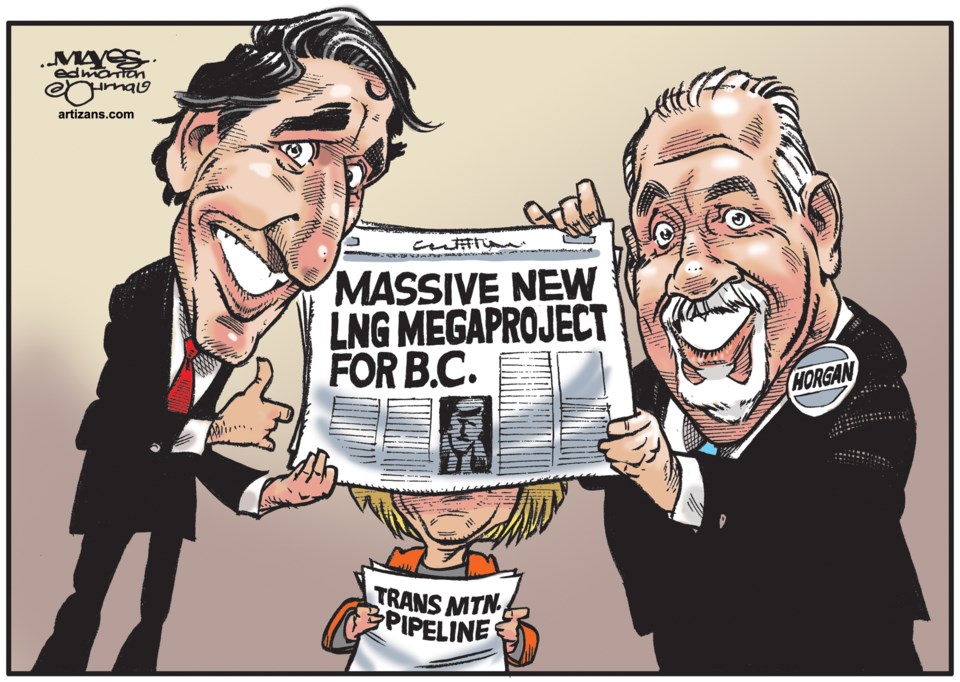As the editorial cartoon shows, British Columbia just nailed a $40 billion liquified natural gas (LNG) project. And Alberta is left looking on.
The LNG Canada announcement is going to be a tremendous boon to B.C., creating a new industry. It will spur billions of dollars of natural gas development in northeast B.C., some of which will end up using the electricity from the Site C hydro dam currently under construction. Thousands of jobs will be created in construction, and thousands more in the industry to supply the completed LNG terminal. There’s going to be a pipeline, built by TransCanada, called the Coastal GasLink, going to Kitimat. There, British Columbia natural gas will be liquified and loaded on LNG carriers, i.e., ships, for Asia.
Good for them.
Too bad we never got around to building that other pipeline that was supposed to go to Kitimat. What was it? Oh yeah, the Northern Gateway. It was supposed to run to the coast, to Kitimat, where its contents would be loaded onto tankers, i.e. ships, for Asia.
But wait! Didn’t our august prime minister tell us on Nov. 29, 2016, “The Great Bear Rainforest is no place for a pipeline and the Douglas Channel is no place for oil tanker traffic.”
Indeed, so much so, the Natural Resources Canada website now says of Northern Gateway, “The Government of Canada has directed the National Energy Board (NEB) to dismiss the Northern Gateway Pipelines project application. The Government has determined that the project is not in the public interest because it would result in crude oil tankers transiting through the sensitive ecosystem of the Douglas Channel, which is part of the Great Bear Rainforest.”
So how does the Coastal GasLink get to Kitimat, and then its LNG carriers out to sea, except through this Great Bear Rainforest, the place whose name magically appeared out of the coastal fog a few years ago? Ironically, the B.C. government’s website for the Great Bear Rainforest shows that Kitimat is not in the defined area, but rather the coast beyond Kitimat is.
So maybe that’s why they can build a natural gas pipeline to Kitimat, but not a bitumen pipeline.
Maybe it’s because the Coastal GasLink is all within the borders of British Columbia, and therefore it doesn’t need National Energy Board (i.e. federal) approval, whereas Northern Gateway did. But Northern Gateway did get NEB approval back in 2013, with 209 conditions. Then some court malarkey took place. Around this time, Prime Minister Justin Trudeau banned tanker traffic in Northern British Columbia waters. That’s oil tankers, not LNG tankers. We can’t ban those, you know.
Perhaps the process for building Coastal GasLink will be different. Instead of doing bores across roads and rivers, they’ll have a Star Trek Transporter on each side of the barrier. Why they wouldn’t use this to cover the entire distance to Kitimat, we’re not sure, but there must be a good reason.
Otherwise, they’re probably going to use the same excavators, sidebooms, dozers, graders and welding rigs for Coastal GasLink as they would have for Northern Gateway. Not just the same type, but the exact same equipment, right down to the serial numbers, run by the very same operators, doing the same thing they always do – build pipelines.
And they’ll do it with the same exacting high standards, too.
The pipe will probably, hopefully, come from the same steel mill in Regina.
The route isn’t the same. Coastal GasLink takes a somewhat more southernly route. Maybe that’s the ticket. We all know that it’s best for pipeline and powerlines to, wherever possible, take common corridors. So maybe Northern Gateway had the wrong route. Well, that should be easy to solve. Now that we know where a pipeline, a gas pipeline, can be built, it shouldn’t be too hard to build a bitumen and a condensate pipeline 20 metres over. Coastal GasLink can blaze the trail, quite literally.
But it will never happen under Trudeau.
All these lamentations over Northern gateway, and the tens of millions of dollars Western Canada is losing, daily, on price differentials as a result, can lead one to become miserable. But there is a bit of hope in some late-breaking news.
As much as we hate the idea of selling our oil to only one customer, that customer may soon need more of our heavy oil, right away. Sister publication Daily Oil Bulletin reported on Oct. 22 that Mexico’s newly elected president, Andres Manuel Lopez Obrador (AMLO), announced he plans to end exports of all Mexican crude oil after he assumes power this December.
That will put a halt to exports of 681,000 bpd of heavy crude to U.S. refineries, principally along the Gulf Coast. In the meantime, TransCanada is gearing up to finally start construction of the Keystone XL pipeline after an over-decade-long odyssey. (It took Homer less time to get home to Ithaca after the Trojan War than it has taken to get this pipeline construction started.)
And where does that pipeline lead to? The Gulf Coast refineries that will soon be deprived of Mexican Mayan crude, and with enough capacity to replace all of it, and then some.
If AMLO does indeed carry out with this plan, the heavy oil discount should diminish in short order. And Keystone XL might finally be the right pipeline at the right place at the right time.
Maybe then we can stop squawking about differentials.



